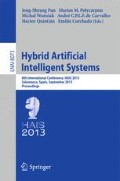Abstract
Cellular Automata are important tools in the study of complex interactions and analysis of emergent behaviour. They have the ability to generate highly complex behaviour starting from a simple initial configuration and set of update rules. Finding rules that exhibit a high degree of self-organization is a challenging task of major importance in the study of complex systems. In this paper, we propose a new cellular automaton (CA) topology and neighbourhood that can be used in the discovery of rules that trigger coordinated global information processing. In the introduced approach, the state of a cell changes according to the cell itself, the cells in the local neighborhood as well as some fixed long-distance cells. The proposed topology is engaged to detect new rules using an evolutionary search algorithm for the well-known density classification task. Experiments are performed for the one-dimensional binary-state CA and results indicate a good performance of the rules evolved by the proposed approach.
Access this chapter
Tax calculation will be finalised at checkout
Purchases are for personal use only
Preview
Unable to display preview. Download preview PDF.
References
Chira, C., Gog, A., Lung, R.I., Iclanzan, D.: Complex Systems and Cellular Automata Models in the Study of Complexity. Studia Informatica Series LV(4), 33–49 (2010)
Crutchfield, J.P., Mitchell, M.: The evolution of emergent computation. Proceedings of the National Academy of Sciences, USA 92(23), 10742–10746 (1995)
Darabos, C., Giacobini, M., Tomassini, M.: Performance and Robustness of Cellular Automata Computation on Irregular Networks. Advances in Complex Systems 10, 85–110 (2007)
Darabos, C., Tomassini, M., Di Cunto, F., Provero, P., Moore, J.H., Giacobini, M.: Toward robust network based complex systems: from evolutionary cellular automata to biological models. Intelligenza Artificiale 5(1), 37–47 (2011)
Das, R., Mitchell, M., Crutchfield, J.P.: A genetic algorithm discovers particle-based computation in cellular automata. In: Davidor, Y., Männer, R., Schwefel, H.-P. (eds.) PPSN 1994. LNCS, vol. 866, pp. 344–353. Springer, Heidelberg (1994)
Ferreira, C.: Gene Expression Programming: A New Adaptive Algorithm for Solving Problems. Complex Systems 13(2), 87–129 (2001)
Gog, A., Chira, C.: Dynamics of Networks Evolved for Cellular Automata Computation. In: Corchado, E., Snášel, V., Abraham, A., Woźniak, M., Graña, M., Cho, S.-B. (eds.) HAIS 2012, Part II. LNCS, vol. 7209, pp. 359–368. Springer, Heidelberg (2012)
Hordijk, W., Crutchfield, J.P., Mitchell, M.: Mechanisms of Emergent Computation in Cellular Automata. In: Eiben, A.E., Bäck, T., Schoenauer, M., Schwefel, H.-P. (eds.) PPSN 1998. LNCS, vol. 1498, pp. 613–622. Springer, Heidelberg (1998)
Juille, H., Pollack, J.B.: Coevolving the ‘ideal’ trainer: Application to the discovery of cellular automata rules. Genetic Programming 1998: Proceedings of the Third Annual Conference (1998)
Juille, H., Pollack, J.B.: Coevolutionary learning and the design of complex systems. Advances in Complex Systems 2(4), 371–394 (2000)
Koza, J.R.: Genetic Programming: On the Programming of Computers by Means of Natural Selection. MIT Press, Cambridge (1992)
Land, M., Belew, R.K.: No perfect two-state cellular automata for density classification exists. Physical Review Letters 74(25), 5148–5150 (1995)
Marques-Pita, M., Mitchell, M., Rocha, L.M.: The role of conceptual structure in designing cellular automata to perform collective computation. In: Calude, C.S., Costa, J.F., Freund, R., Oswald, M., Rozenberg, G. (eds.) UC 2008. LNCS, vol. 5204, pp. 146–163. Springer, Heidelberg (2008)
Mitchell, M., Crutchfield, J.P., Das, R.: Evolving cellular automata with genetic algorithms: A review of recent work. In: Proceedings of the First International Conference on Evolutionary Computation and Its Applications, EvCA 1996. Russian Academy of Sciences (1996)
Mitchell, M., Thomure, M.D., Williams, N.L.: The role of space in the Success of Coevolutionary Learning. In: Proceedings of ALIFE X - The Tenth International Conference on the Simulation and Synthesis of Living Systems (2006)
Oliveira, G.M.B., Martins, L.G.A., de Carvalho, L.B., Fynn, E.: Some investigations about synchronization and density classification tasks in one-dimensional and two-dimensional cellular automata rule spaces. Electron. Notes Theor. Comput. Sci. 252, 121–142 (2009)
Packard, N.H.: Adaptation toward the edge of chaos. In: Dynamic Patterns in Complex Systems, pp. 293–301. World Scientific (1988)
Pagie, L., Mitchell, M.: A comparison of evolutionary and coevolutionary search. Int. J. Comput. Intell. Appl. 2(1), 53–69 (2002)
Tomassini, M., Venzi, M.: Evolution of Asynchronous Cellular Automata for the Density Task. In: Guervós, J.J.M., Adamidis, P.A., Beyer, H.-G., Fernández-Villacañas, J.-L., Schwefel, H.-P. (eds.) PPSN 2002. LNCS, vol. 2439, pp. 934–943. Springer, Heidelberg (2002)
Tomassini, M., Giacobini, M., Darabos, C.: Evolution and dynamics of small-world cellular automata. Complex Systems 15, 261–284 (2005)
Watts, D.J., Strogatz, S.H.: Collective dynamics of ‘smallworld’ networks. Nature 393, 440–442 (1998)
Watts, D.J.: Small Worlds: The Dynamics of Networks Between Order and Randomness. Princeton University Press, Princeton (1999)
Wolfram, S., Theory and Applications of Cellular Automata. Advanced series on complex systems. World Scientific Publishing (1986)
Author information
Authors and Affiliations
Editor information
Editors and Affiliations
Rights and permissions
Copyright information
© 2013 Springer-Verlag Berlin Heidelberg
About this paper
Cite this paper
Andreica, A., Chira, C. (2013). Using a Hybrid Cellular Automata Topology and Neighborhood in Rule Discovery. In: Pan, JS., Polycarpou, M.M., Woźniak, M., de Carvalho, A.C.P.L.F., Quintián, H., Corchado, E. (eds) Hybrid Artificial Intelligent Systems. HAIS 2013. Lecture Notes in Computer Science(), vol 8073. Springer, Berlin, Heidelberg. https://doi.org/10.1007/978-3-642-40846-5_67
Download citation
DOI: https://doi.org/10.1007/978-3-642-40846-5_67
Publisher Name: Springer, Berlin, Heidelberg
Print ISBN: 978-3-642-40845-8
Online ISBN: 978-3-642-40846-5
eBook Packages: Computer ScienceComputer Science (R0)

